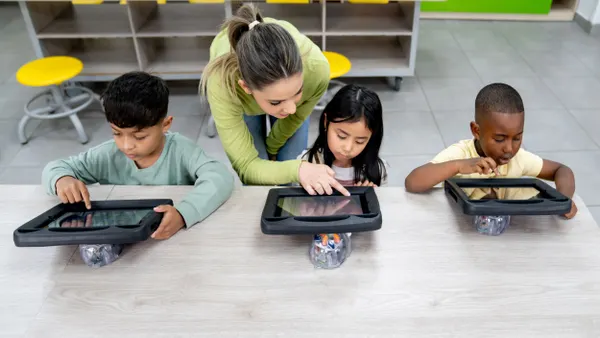Dive Brief:
- As schools nationwide make progress toward reopening for in-person learning, the Universal Design for Learning framework can be applied to help educators juggle the task of designing lesson plans across in-person, distance and hybrid learning models, University of Kansas Center for STEM Learning master teacher Michael Ralph writes for Edutopia.
- Based on UDL, Ralph suggests educators begin the process of planning lessons with the most essential idea or skill they want students to take away, building from there to determine how available tools or processes can meet that goal. He also adds that content delivery may need to vary between in-person, online and hybrid models to play to the strengths of each.
- Finally, Ralph stresses the importance of flexibility in being able to adapt different approaches to lessons for different learning models, as well as remaining transparent about learning norms and expectations.
Dive Insight:
The UDL model was conceived as a means of providing all students the opportunity to excel. For example, it's often used as an inclusive instruction framework for integrating special education students in general ed environments. The framework has also been used to provide expanded learning options for general education students and to help educators create nurturing, equitable and inclusive spaces more broadly.
The UDL guidelines include providing multiple means of engagement, representation, and action and expression. The intention is to create learners who are purposeful and motivated, resourceful and knowledgeable, and strategic and goal-directed — all the while providing multiple pathways to those goals.
Techniques for doing so may include posting lesson goals so students understand what they are trying to achieve, giving assignment options to allow students to use their own skills and interests to demonstrate knowledge, and providing flexible workspaces. Providing both digital and audio text can also ensure all students have access to the same materials. The idea is to ensure all students can excel despite their differing underlying talents.
Taking an approach where flexibility is top of mind is particularly crucial as many schools ease into full in-person returns with hybrid models, where groups of students alternate being online and in-person from day-to-day but are taught simultaneously. The demands have further strained educators' work-life balances, with a Tennessee Education Association survey administered during fall showing 84% of teachers reported working 13 hours a week more than normal during the first 18 weeks of the school year.
One method educators have also utilized to bridge divides between digital and in-person students during hybrid learning is building strong culture around activities like morning meetings and closing circles, or utilizing joint periods of fun time that allow for in-person students to participate through Zoom or similar platforms so they can be in breakout social rooms with any peer.












